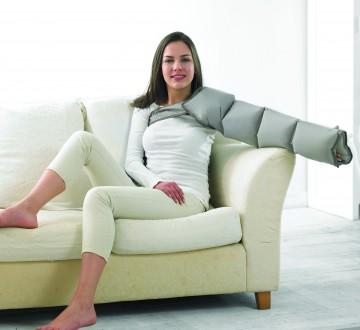The goal of treatment is to control the swelling and other problems and complications caused by lymphedema.
Treatment of lymphedema may include the following:
Pressure garments
 Pressure garments are made of fabric that puts a controlled amount of pressure on different parts of the arm or leg to help move fluid and keep it from building up. Some patients may need to have these garments custom-made for a correct fit. Bandaging (wrapping) can be an alternative. Wearing a pressure garment during exercise may help prevent more swelling in an affected limb. It is important to use pressure garments during air travel, because lymphedema can become worse at high altitudes. Pressure garments are also called compression sleeves and lymphedema sleeves or stockings.
Pressure garments are made of fabric that puts a controlled amount of pressure on different parts of the arm or leg to help move fluid and keep it from building up. Some patients may need to have these garments custom-made for a correct fit. Bandaging (wrapping) can be an alternative. Wearing a pressure garment during exercise may help prevent more swelling in an affected limb. It is important to use pressure garments during air travel, because lymphedema can become worse at high altitudes. Pressure garments are also called compression sleeves and lymphedema sleeves or stockings.
Exercise
Both light exercise and aerobic exercise help the lymph vessels move lymph out of the affected arm and decrease swelling. Patients who have lymphedema should wear a well-fitting pressure garment during exercise that use the affected arm. Patients who do not have lymphedema do not need to wear a pressure garment during exercise.
Studies in breast cancer patients show that upper-body exercise is safe in women who have lymphedema or who are at risk for lymphedema. Weight-lifting that is slowly increased may keep lymphedema from getting worse. Exercise should start at a very low level, increase slowly over time, and be overseen by the lymphedema therapist. If exercise is stopped for a week or longer, it should be started again at a low level and increased slowly.
Check with your doctor about the best time to start exercising your arms as well as any weight restrictions.
Arm and hand care
The goal of skin and nail care is to prevent infections:

- Keep hands always clean.
- Use cream or lotion to keep the skin moist.
- Treat small cuts or breaks in the skin with an antibacterial ointment.
- Avoid needle sticks of any type into the affected arm (ask to have blood drawn from the other arm)
- Use a thimble for sewing.
- Wear gloves when gardening and cooking.
- Wear sunscreen when outdoors.
- Cut nails straight across
- Wear only loose jewelry and clothes without tight bands or elastic.
- Do not use a blood pressure cuff on the arm with lymphedema.
- Keep the limb with lymphedema raised higher than the heart when possible. Put it on a pillow when in bed.
Compression device

Compression devices are pumps connected to a sleeve that wraps around the arm and applies pressure on and off. The sleeve is inflated and deflated on a timed cycle. This pumping action may help move fluid through lymph vessels and veins and keep fluid from building up in the arm. Compression devices may be helpful when added to combined therapy. The use of these devices should be supervised by a trained professional because too much pressure can damage lymph vessels near the surface of the skin.
The device is usually used at night. If your doctor recommends, it you’d better try it first before buying it.
Massage therapy
Massage therapy for lymphedema should begin with someone specially trained in treating lymphedema. In this type of massage, the soft tissues of the body are lightly rubbed, tapped, and stroked. It is a very light touch, almost like a brushing. Massage may help move lymph out of the swollen arm. Patients can be taught to do this type of massage therapy themselves.
Massage should not be done on any of the following:
- Open wounds, bruises, or areas of broken skin.
- Deep vein thrombosis (blood clot in a vein).
- Sensitive soft tissue where the skin was treated with radiation therapy.
Weight loss
In patients who are overweight, lymphedema related to breast cancer may improve with weight loss.
Combined therapy
Combined physical therapy is a program of massage, bandaging, exercises, and skin care managed by a trained therapist. At the beginning of the program, the therapist gives many treatments over a short time to decrease most of the swelling in the limb with lymphedema. Then the patient continues the program at home to keep the swelling down. Combined therapy is also called complex decongestive therapy.
Laser therapy
Some therapists find that laser therapy is a valuable add-on to the treatment plan, especially when there’s a significant amount of thick, hard scar tissue under the skin (known as fibrosis). However, more evidence from research studies is needed to make definite recommendations about the best use of laser therapy.
Drug therapy
Lymphedema is not usually treated with drugs. Antibiotics may be used to treat and prevent infections. Other types of drugs, such as diuretics or anticoagulants (blood thinners), are usually not helpful and may make the lymphedema worse. Diuretics may alleviate symptoms temporarily, but they should generally be avoided. Check with your doctor.
